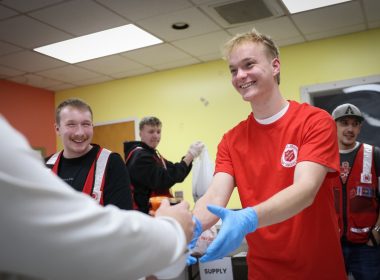A Henry Moore sculpture stands on the grounds of the Kroc Center |
“Two weeks before she died,” recalled Captain Cindy Foley, who serves with her husband Captain Tim Foley as co-administrators of the Kroc Center, “Mrs. Kroc visited the center in her wheelchair. She had given a sculpture and wanted to see it in its place in the garden. She came unexpectedly that day, as she often did—just phoning when she was five minutes away.”
Mrs. Kroc not only saw the six-foot tall, 10-ton, solid bronze sculpture—the original casting by Henry Moore—but Foley was able to give her some additional good news. “When she got here, I told her we had just finalized an arrangement with the San Diego Symphony to do a series at our performing arts center. She was thrilled.”
Before the center was built, Foley said “We had been told ‘her dream was so big that The Salvation Army would have to catch up with her.’ But the reality of what the center has become and its impact—on the neighborhood, on people’s lives, and on the community—was beyond her wildest expectations. She was absolutely thrilled.”
According to Foley, Mrs. Kroc took great pride in being a ‘hands-off’ donor. She gave gifts to those she trusted, and then didn’t interfere with what was being done. “She was more like a great-aunt than a donor. She was as excited about the accomplishments of the center’s kids as she was about those of own her grandchildren and great-grandchildren, whom she often brought to children’s parties at the center.
“One of the things she liked about The Salvation Army was that it wasn’t just a service provider, but was interested in the spiritual life and development of individuals. She loved it that we have a church here, and could provide services to the whole person.”
Sharing her love of art, as she did in her gift of the sculpture, was one of the many ways Joan Kroc touched lives in the community. “This neighborhood now has a significant piece of art,” said Foley, “It was important to her that the average person could experience art.”
She recalled something that happened the day after Mrs. Kroc’s visit, when the center hosted its monthly meeting for parents and children of the Down Syndrome society.
“I looked over at the sculpture, and saw a father with three young boys—triplets with Down syndrome—who were climbing on it and crawling inside it. For a moment, I was shocked. Then I thought—they’re experiencing art like 3-year-olds do. And I hoped 10-year-olds would enjoy it as 10-year-olds do, and that teenagers would enjoy it in their own way as well.”
That, no doubt, is what Joan Kroc had in mind.









